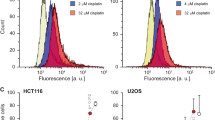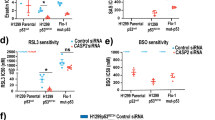Abstract
The human leukemia cell line, HL60 is very sensitive to various apoptotic stimuli and p53-null. The death-related cysteine proteases of the caspases family play a central role in the execution phase of apoptosis, and we recently reported the importance of serine protease activation in camptothecin-induced apoptotic endonuclease activation in HL60 cells. In the present study, we investigated the role of caspases (ICE/CED-3-related cysteine proteases) and serine proteases in cell death induced by the topoisomerase I inhibitor, camptothecin, in HL60 cells and in a cell-free system. We found that CPP32 is activated during camptothecin-induced apoptosis, and that N-benzyloxycarbony-Val-Ala-Asp (O-methyl) -fluoromethyketone (Z-VAD-fmk), a cell permeable caspase inhibitor blocks all features of apoptosis: morphological changes, cleavage of caspase 3 (CPP32/Yama/Apopain) and poly(ADP-ribose) polymerase, lamin B degradation and DNA fragmentation. However, Z-VAD-fmk and two other ICE/CED-3 inhibitors, YVAD-CHO and DEVD-CHO, were inactive in a cell-free system reconstituted from nuclei of untreated HL60 cells and cytosol from camptothecin-treated cells, suggesting that caspases are not required for endonuclease activation or lamin B cleavage in the cell-free system. By contrast, the serine protease inhibitors, 3,4-dichloroisocoumarin (DCI) and L-1-chloro-3-(4-tosylamido)-4-phenyl-2-butanone tosyl- L-phenylalanine chloromethyl ketone (TPCK), abolished the apoptosis-associated biochemical changes induced by camptothecin both in whole cells and in a cell-free system. DCI also inhibited CPP32 cleavage. Taken together, these results suggest that in HL60 cells, both CPP32 and serine proteases are activated in camptothecin-induced apoptosis.
This is a preview of subscription content, access via your institution
Access options
Subscribe to this journal
Receive 12 print issues and online access
$259.00 per year
only $21.58 per issue
Buy this article
- Purchase on Springer Link
- Instant access to full article PDF
Prices may be subject to local taxes which are calculated during checkout
Similar content being viewed by others
Author information
Authors and Affiliations
Rights and permissions
About this article
Cite this article
Shimizu, T., Pommier, Y. Camptothecin-induced apoptosis in p53-null human leukemia HL60 cells and their isolated nuclei: effects of the protease inhibitors Z-VAD-fmk and dichloroisocoumarin suggest an involvement of both caspases and serine proteases. Leukemia 11, 1238–1244 (1997). https://doi.org/10.1038/sj.leu.2400734
Received:
Accepted:
Issue Date:
DOI: https://doi.org/10.1038/sj.leu.2400734
Keywords
This article is cited by
-
Mechanism of action of non-camptothecin inhibitor Genz-644282 in topoisomerase I inhibition
Communications Biology (2022)
-
Oridonin inhibits DNMT3A R882 mutation-driven clonal hematopoiesis and leukemia by inducing apoptosis and necroptosis
Cell Death Discovery (2021)
-
The benzylisoquinoline alkaloids, berberine and coptisine, act against camptothecin-resistant topoisomerase I mutants
Scientific Reports (2021)
-
Expression of caspase 3 in ovarian follicle cells of the lizard Podarcis sicula
Cell and Tissue Research (2017)
-
Heat-shock protein 60 translocates to the surface of apoptotic cells and differentiated megakaryocytes and stimulates phagocytosis
Cellular and Molecular Life Sciences (2011)



